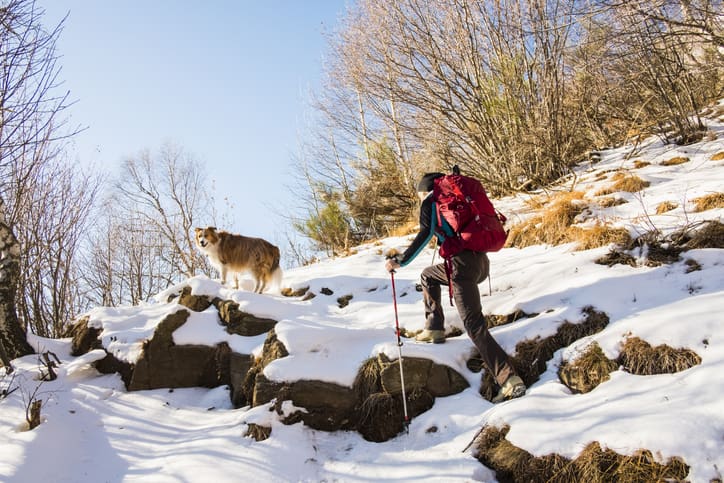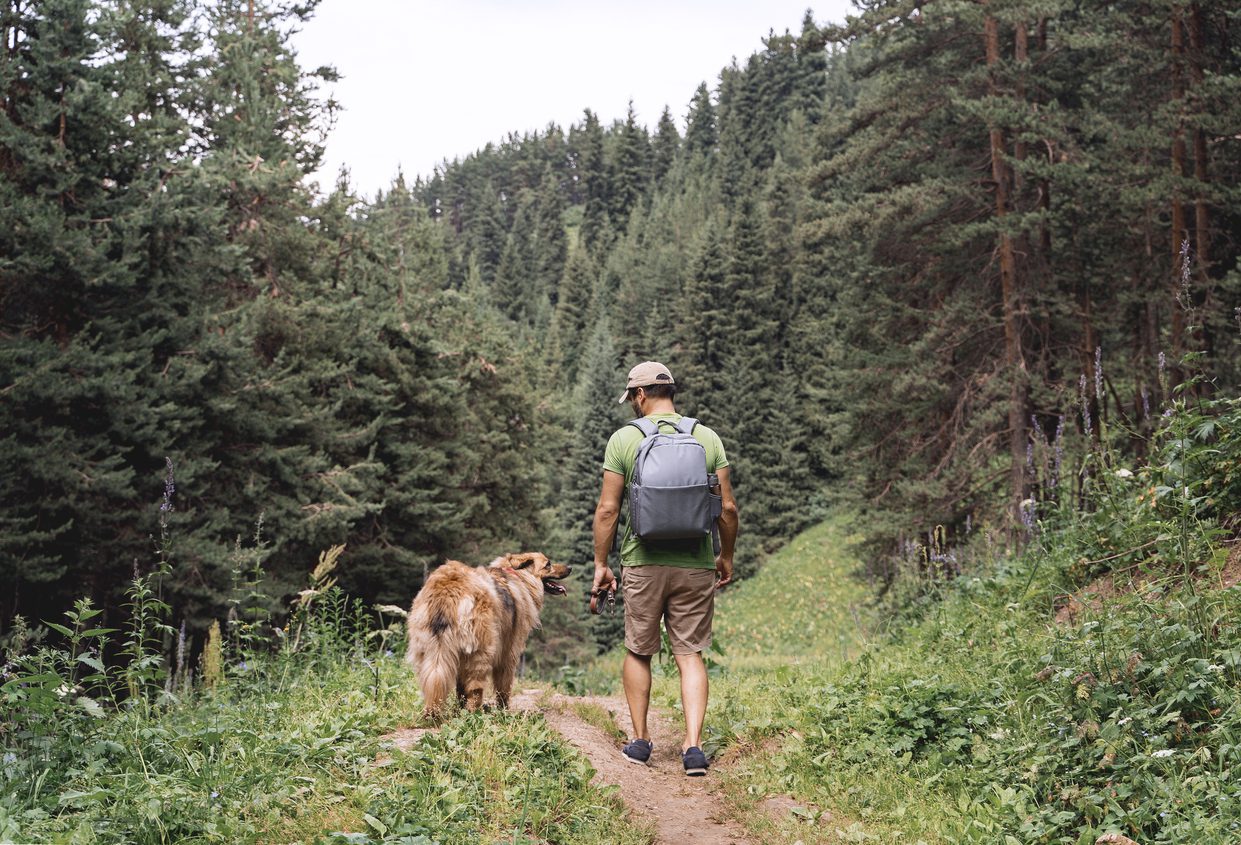Hiking with your dog is one of the best ways to enjoy the outdoors and strengthen your bond with your furry friend. For many of us, our dog is more than just a pet—our fur baby, a cherished family member, and a loyal hiking companion, making every adventure even more special. But to ensure a safe and enjoyable adventure, every dog owner needs to be prepared with the right hiking gear, starting with a well-packed dog hiking bag or backpack.
Whether it’s your first day hike or planning overnight backpacking trips with your pup, packing the essentials can make a big difference. Here’s everything you should consider bringing on your next trail adventure with your four-legged friend.
Introduction to Hiking with Your Dog
Hiking with your dog is a fantastic way to explore the outdoors and create lasting memories with your furry friend. Before you set out on the trails, you must ensure your pup is ready for the adventure. Start by assessing your dog’s fitness level and energy level—some dogs are natural trailblazers, while others may need a little conditioning before tackling longer hikes. Training your dog to walk politely on a leash and introducing them to hiking gear, like a dog hiking backpack or dog pack, will help ensure a smooth experience for you and your pup. With the proper preparation and the perfect pack, walking with your dog can be rewarding, opening up a world of new trails to discover together.
Why Use a Dog Hiking Bag or Dog Pack?
A dog hiking pack allows your pup to carry some of their supplies, such as water, food, or poop bags, giving them a job and sharing the load. It’s especially helpful on long hikes or thru-hikes when you’re out for hours or days.
If you’re wondering how much weight your dog can safely carry, a good rule is about 10–15% of your dog’s body weight. This varies by breed, size, and fitness level, so check with your veterinarian if you’re unsure. Larger dogs can typically carry more weight, but it's essential to ensure the dog's backpack fits correctly, is not overloaded, and distributes weight evenly for safety and comfort. Consulting your vet is especially important for larger dogs or if you are unsure about your dog's ability to carry a pack.
Choosing the Right Gear
Selecting the right hiking gear is key to making your outdoor adventures safe and enjoyable for you and your dog. A well-fitted dog hiking backpack allows your pup to carry their essentials, while dog boots can protect their paws from rough terrain. When choosing gear, consider the type of hiking you’ll do, the weather, and your dog’s unique needs. The right hiking backpack and dog boots can make a big difference in your dog’s comfort and safety on the trail, so take the time to find gear that fits well and is designed for hiking with your dog.
Dog Backpacks
Dog backpacks, or dog packs, are an excellent way for your dog to help carry their gear, such as food, water, and poop bags, on the trail. When shopping for a dog backpack, consider your dog’s size, weight, and the length of your hikes. Look for dog backpacks with adjustable straps and padded panels to ensure a comfortable fit that won’t chafe or restrict movement. Many dog owners love the Outward Hound DayPak, which offers a secure, adjustable fit and enough space for your dog’s essentials. The best dog backpacks are lightweight, durable, and easy for your dog to wear, making them a must-have for hiking with dogs of all sizes.
Dog Carry Options
Not every dog is suited to carrying a pack, especially smaller pups or those with health concerns. For these dogs, dog carry options like slings or carriers can be an excellent alternative for shorter hikes or when your dog needs a break. When choosing a dog carry solution, consider your dog’s weight and size, and your own comfort and ability to carry your dog safely. Dog backpacks and carriers come in various styles, so you can find one that works for you and your pup, ensuring everyone enjoys the hike.
Trail Preparation
Before you and your dog hit the trail, a little preparation goes a long way toward a safe and enjoyable hike. Start by checking the weather and trail conditions, and make sure dogs are allowed on your chosen route. Some trails have specific regulations or require dogs to be on a leash at all times, so be sure to review the rules and pack a sturdy leash. Bring plenty of water, food, snacks for your dog, a first aid kit, and other essential hiking gear. If your hike includes water crossings or swimming, a dog life jacket is a brilliant addition to your pack. Don’t forget to bring enough poop bags to clean up after your pup and help keep the trails beautiful for everyone. By preparing ahead and following trail etiquette, you and your dog can enjoy a safe, fun, and memorable hiking adventure together.
Essential Items to Pack in Your Dog Hiking Bag
1. Water and Collapsible Bowl
Hydration is critical during any hike. Make sure to pack enough water bottles for your dog, and consider bringing two water bottles to help evenly distribute the weight in your dog's backpack. Pack water in a dedicated dog water bottle or use your own, but always bring a collapsible bowl so your dog can drink easily. Dogs can overheat fast, especially on hot days, so frequent water breaks are necessary.
When hiking, keep your dog away from natural water sources to avoid contamination. Always follow Leave No Trace principles by cleaning up after your dog at a safe distance from any water source.
2. Dog Food and Trail Snacks
Bring enough dog food or high-protein snacks to keep your pup’s energy up during the hike. Treats can also serve as rewards during training or to encourage rest stops.
3. Leash and Harness
Even if your dog usually runs free, most trails require leashed dogs for safety and trail etiquette. Hence, choosing a durable dog leash with secure attachment points like a V-ring and safety features such as reflective trim or attachment loops is essential. Pack a sturdy leash and a comfortable, well-made harness with sturdy metal rings to keep your dog secure—these harnesses are essential for both comfort and safety during hikes.
Using leashes is crucial for maintaining control, complying with trail regulations, and ensuring good trail etiquette. Adjustable straps on the harness and pack improve comfort and fit.
4. Poop Bags
Always respect the trail and pack out after your pet. Bring plenty of poop bags and dispose of them responsibly.
5. Dog Boots or Paw Protection
On rough terrain or muddy paws, dog booties are an excellent option for protecting your dog's paws on rough or hot surfaces, while dog boots or paw balm can protect your pup’s paws from injury and discomfort. Caring for your dog's paws is especially important if you hike on rocky, abrasive, or icy trails, as these conditions can cause cuts, abrasions, or even frostbite.
Additionally, consider protecting your dog's nose from sunburn or environmental hazards during outdoor activities.
6. First Aid Kit for Dogs
Prepare a small first aid kit with essentials like antiseptic wipes, bandages, hydrogen peroxide (for cleaning wounds), a tick remover, and medications. This kit is crucial if your dog encounters scrapes, bites, or insect stings.
7. Extra Towel
An extra towel comes in handy to dry muddy paws or your dog after a swim in a lake or stream.
Additional Dog Hiking Gear to Consider
- A dog life jacket if your trail includes swimming or boating
- Dog wear, such as cooling vests for summer or jackets for cold hikes
- Bright colors or reflective gear to improve visibility
- Dog's backpack with adjustable straps for a comfortable, secure fit; ensure the backpack fits properly around your dog's chest to avoid chafing and keep your dog comfortable. Gradually introduce your dog to wearing a backpack during regular walking sessions to help them adjust to carrying gear safely and effectively.
- A dog bed or mat for resting during breaks or overnight trips
Tips for Packing Your Dog’s Hiking Bag
- Start slowly: Take your pup on short walks and day hikes with a light pack, gradually increasing the weight and duration. This helps your dog get used to carrying a pack before a long hike.
- Distribute weight evenly: Place heavier items near your dog’s chest and balance the sides.
- Watch for signs of fatigue: If your dog is lagging or reluctant, it may be time to rest or lighten their load.
- Keep your dog safe: Stick to dog-safe trails and follow trail etiquette, keeping your pup leashed and respecting wildlife.
- Bring your vet’s advice: Consult your veterinarian before long hikes, especially if your dog has health issues or is older.
Choosing the Best Dog Hiking Pack
Brands like Outward Hound offer popular dog backpacks designed for comfort and durability. Look for features like:
- Adjustable straps
- Padded chest panels
- Lightweight and breathable materials
- Reflective accents for safety
Final Thoughts

Packing the right gear in your dog’s hiking bag is essential for a successful and enjoyable hike. Whether you’re hitting the trail for a quick day hike or planning more ambitious backpacking trips, being prepared will keep your furry friend happy, healthy, and comfortable every step.
Happy hiking to both you and your pup!




